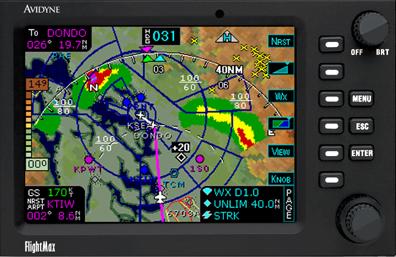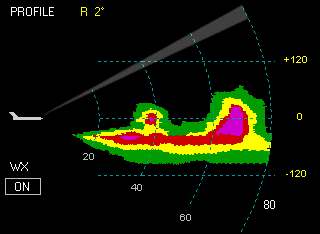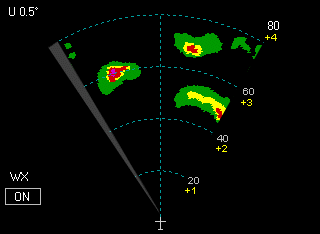

Existing FlightMax 740 systems can also be upgraded to these new features. Here’s a brief description of FlightMax’s new radar enhancing features:
BeamView: Displays a sweeping “flashlight beam” which corresponds to the beam width of the radars’ antenna diameter .By displaying the radar’s beam width as a function of range, pilots can more easily discern targets that are separated by a distance of less than a beam width and which appear on the screen as a single target. BeamView improves the pilot’s ability to identify cells which are distorted by the natural physics of radar, especially at longer ranges where beam width is greatest.
TiltView: A function of the radar’s tilt setting, TiltView computes the relative altitude of the radar beam at each range, and displays this information in yellow adjacent to each range arc on the display scale in thousands of feet.

“FlightMax takes existing radar systems and makes them better, and these radar enhancements are another step forward in our constant quest for improving the presentation of data in the cockpit, increasing safety and adding value,” said Carl Wolf, Avidyne’s director of aftermarket sales and marketing. “With interfaces for 19 different radar systems and counting, and with innovative product enhancements like these, FlightMax continues to be the radar indicator of choice for corporate, regional airline, and owner-flown aircraft.”
“Avidyne’s goal is to revolutionize the way information is managed and displayed by providing the most advanced, highly flexible, situational awareness technology for today’s cockpit,” said Dan Schwinn, president of Avidyne Corporation. “FlightMax’s growing list of safety-enhancing capabilities continues to deliver on that goal.”
About FlightMax Avidyne currently produces three radar-capable FlightMax models, the FlightMax 850, 750, and 650, which interface to a growing list of new and existing radar systems.In addition, a non-radar equivalent FlightMax 450 provides all the mapping and display capability of the others. All FlightMax systems include the ability to display Stormscope lightning when interfaced with a BFG WX-500, a traffic display when interfaced with BFG Skywatch, Ryan TCAD 9900B, or an optional interface for BFG 791 or Honeywell CAS 66A TCAS I systems . Digitized IFR & VFR charts are also available on the FlightMax 750, 650, and 450.
As the centralized display of all safety-related data, FlightMax sets a new standard for situational awareness and information management in business and commercial aircraft. For radar-equipped aircraft, FlightMax provides the only cost-effective means for upgrading legacy radars while delivering the situational awareness benefits typically associated with today's integrated glass cockpits. Existing FlightMax 740 and 440 models can easily be upgraded to the capabilities of the FlightMax 750 and 450, respectively.
New FlightMax features provide the pilot with increased ability to track and interpret weather radar data, increasing situational awareness and safety.
Lincoln, MA.—September 8, 2000—Avidyne today announced that in addition to its recently-expanded list of radar interfaces and color-contoured terrain capability, all radar-capable FlightMax systems, including the FlightMax 850, 750 and 650, will have three new radar-enhancing features. Exclusive to FlightMax, BeamView and TiltView provide additional information on the radar display which help pilots more easily track and interpret weather radar data. FlightMax also provides an AutoTilt function that is available even when interfaced to radar systems that previously did not support this feature.